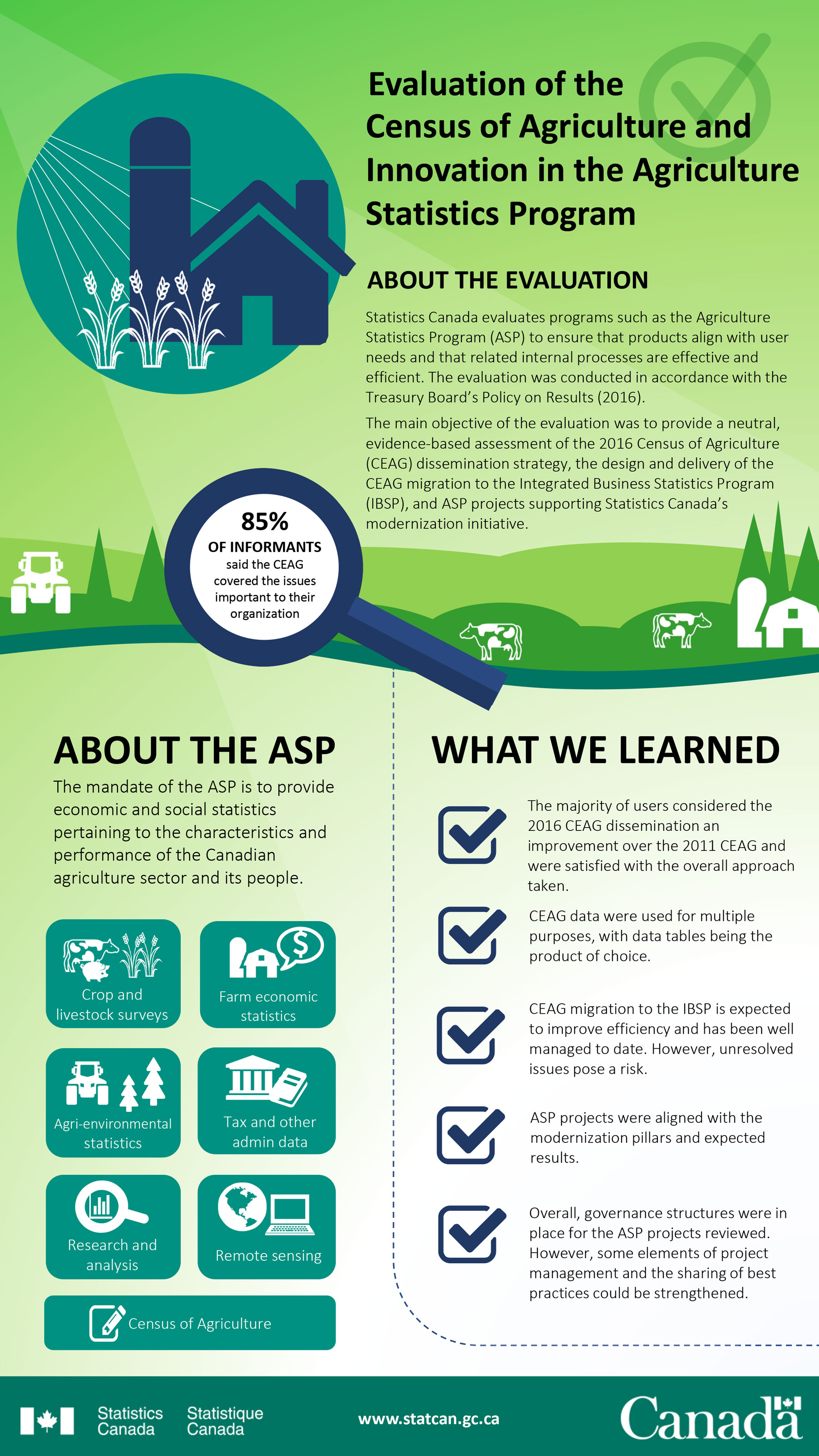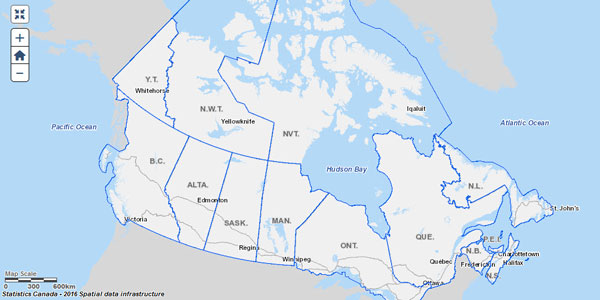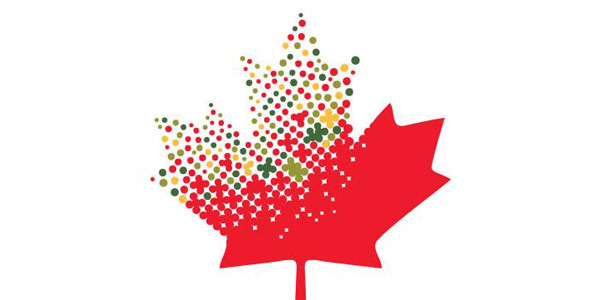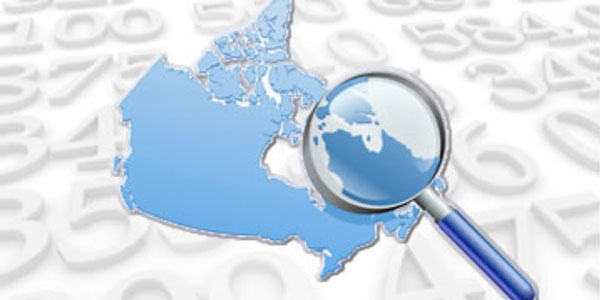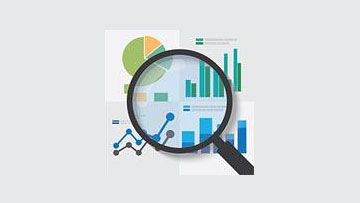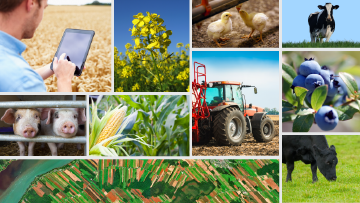Statement of Management Responsibility Including Internal Control over Financial Reporting
Responsibility for the integrity and objectivity of the accompanying financial statements for the year ended March 31, 2020, and all information contained in these statements rests with the management of Statistics Canada (the agency). These financial statements have been prepared by management using the Government of Canada's accounting policies, which are based on Canadian public sector accounting standards.
Management is responsible for the integrity and objectivity of the information in these financial statements. Some of the information in the financial statements is based on management's best estimates and judgment, and gives due consideration to materiality. To fulfill its accounting and reporting responsibilities, management maintains a set of accounts that provides a centralized record of the agency's financial transactions. Financial information submitted in the preparation of the Public Accounts of Canada, and included in the agency's Departmental Results Report, is consistent with these financial statements.
Management is also responsible for maintaining an effective system of internal control over financial reporting (ICFR) designed to provide reasonable assurance that financial information is reliable, that assets are safeguarded, and that transactions are properly authorized and recorded in accordance with the Financial Administration Act and other applicable legislation, regulations, authorities and policies.
Management seeks to ensure the objectivity and integrity of data in its financial statements through careful selection, training and development of qualified staff; through organizational arrangements that provide appropriate divisions of responsibility; through communication programs aimed at ensuring that regulations, policies, standards, and managerial authorities are understood throughout the agency and through conducting an annual risk-based assessment of the effectiveness of the system of ICFR.
The system of ICFR is designed to mitigate risks to a reasonable level based on an ongoing process to identify key risks, to assess the effectiveness of associated key controls, and to make any necessary adjustments.
A risk-based assessment of the system of ICFR for the year ended March 31, 2020 was completed in accordance with the Treasury Board Policy on Financial Management and the results and action plans are summarized in the annex, which can be found at the end of the notes to these financial statements.
The effectiveness and adequacy of the agency’s system of internal control is reviewed by the work of internal finance staff, who conduct periodic assessments of different areas of the agency’s operations, and by the Departmental Audit Committee (DAC), who provide advice to the Chief Statistician on the adequacy and effectiveness of the agency’s risk management, control and governance frameworks and processes.
The financial statements of Statistics Canada have not been audited.
Anil Arora, Chief Statistician
Ottawa, Canada
October 9, 2020
Monia Lahaie, Chief Financial Officer
Ottawa, Canada
October 9, 2020
Statement of Financial Position (Unaudited)
As at March 31
(in thousands of dollars)
|
|
2020
|
2019
|
|---|
| Liabilities
|
|---|
Accounts payable and accrued liabilities ( note 4)
|
75,031
|
79,357
|
|---|
|
Vacation pay and compensatory leave
|
34,674
|
27,577
|
|---|
|
|
614
|
619
|
|---|
Lease obligation for tangible capital assets ( note 6)
|
0
|
6
|
|---|
Employee future benefits ( note 7)
|
20,520
|
19,280
|
|---|
| Total net liabilities
|
130,839
|
126,839
|
|---|
| Financial assets
|
|---|
|
Due from Consolidated Revenue Fund
|
55,874
|
63,107
|
|---|
Accounts receivable and advances ( note 8)
|
12,276
|
7,316
|
|---|
| Total net financial assets
|
68,150
|
70,423
|
|---|
| Departmental net debt
|
62,689
|
56,416
|
|---|
| Non-financial assets
|
|---|
|
Prepaid expenses
|
5,851
|
4,174
|
|---|
|
Consumable supplies
|
1,561
|
1,098
|
|---|
Tangible capital assets ( note 9)
|
163,237
|
164,985
|
|---|
| Total non-financial assets
|
170,649
|
170,257
|
|---|
| Departmental net financial position
|
107,960
|
113,841
|
|---|
|
Contractual obligations and contractual rights (note 10)
Contingent liabilities and contingent assets (note 11)
The accompanying notes form an integral part of these financial statements.
|
Anil Arora, Chief Statistician
Ottawa, Canada
October 9, 2020
Monia Lahaie, Chief Financial Officer
Ottawa, Canada
October 9, 2020
Statement of Operations and Departmental Net Financial Position (Unaudited)
For the Year Ended March 31
(in thousands of dollars)
|
|
2020
Planned Results
|
2020
|
2019
|
|---|
| Expenses
|
|---|
|
Statistical Information
|
646,031
|
663,599
|
610,940
|
|---|
|
Internal services
|
72,521
|
93,839
|
78,608
|
|---|
| Total expenses
|
718,552
|
757,438
|
689,548
|
|---|
| Revenues
|
|---|
|
Special statistical services
|
138,000
|
143,220
|
143,882
|
|---|
|
Other revenues
|
100
|
72
|
80
|
|---|
|
Revenues earned on behalf of Government
|
(18,100)
|
(21,356)
|
(20,418)
|
|---|
| Total revenues
|
120,000
|
121,936
|
123,544
|
|---|
| Net cost of operations before government funding and transfers
|
598,552
|
635,502
|
566,004
|
|---|
| Government funding and transfers
|
|---|
|
Net cash provided by Government of Canada
|
|
553,096
|
504,373
|
|---|
|
Change in due from Consolidated Revenue Fund
|
|
(7,233)
|
958
|
|---|
Services provided without charge by other federal government departments ( note 12a)
|
|
83,756
|
74,507
|
|---|
|
Transfer of assets to other federal government departments
|
|
2
|
100
|
|---|
| Net cost (revenue) of operations after government funding and transfers
|
|
5,881
|
(13,934)
|
|---|
| Departmental net financial position - Beginning of year
|
|
113,841
|
99,907
|
|---|
| Departmental net financial position - End of year
|
|
107,960
|
113,841
|
|---|
|
Segmented information (note 13)
The accompanying notes form an integral part of these financial statements
|
Statement of Change in Departmental Net Debt (Unaudited)
For the Year Ended March 31
(in thousands of dollars)
|
|
2020
|
2019
|
|---|
| Net cost (revenue) of operations after government funding and transfers
|
5,881
|
(13,934)
|
|---|
| Change due to tangible capital assets
|
|---|
Acquisition of tangible capital assets ( note 9)
|
28,447
|
36,046
|
|---|
Amortization of tangible capital assets ( note 9)
|
(30,146)
|
(27,418)
|
|---|
|
Net loss on disposal of tangible capital assets including adjustments
|
(70)
|
(76)
|
|---|
|
Transfer of tangible capital assets to other federal government departments
|
21
|
95
|
|---|
| Total change due to tangible capital assets
|
(1,748)
|
8,647
|
|---|
| Change due to consumable supplies
|
463
|
(182)
|
|---|
| Change due to prepaid expenses
|
1,677
|
(1,181)
|
|---|
| Net increase (decrease) in departmental net debt
|
6,273
|
(6,650)
|
|---|
| Departmental net debt - Beginning of year
|
56,416
|
63,066
|
|---|
| Departmental net debt - End of year
|
62,689
|
56,416
|
|---|
| The accompanying notes form an integral part of these financial statements.
|
Statement of Cash Flows (Unaudited)
For the Year Ended March 31
(in thousands of dollars)
|
|
2020
|
2019
|
|---|
| Operating activities
|
|---|
|
Net cost of operations before government funding and transfers
|
635,502
|
566,004
|
|---|
|
Non-cash items:
|
|---|
Amortization of tangible capital assets ( note 9)
|
(30,146)
|
(27,418)
|
|---|
|
Loss on disposal of tangible capital assets
|
(70)
|
(76)
|
|---|
Services provided without charge by other federal government departments ( note 12a)
|
(83,756)
|
(74,507)
|
|---|
|
Transfer of emergency salary advances to other federal government departments
|
20
|
(5)
|
|---|
|
Variations in Statement of Financial Position:
|
|---|
|
Increase (decrease) in accounts receivable and advances
|
4,960
|
(1,343)
|
|---|
|
Increase (decrease) in prepaid expenses
|
1,676
|
(1,181)
|
|---|
|
Increase (decrease) in consumable supplies
|
463
|
(182)
|
|---|
|
Decrease in accounts payable and accrued liabilities
|
4,326
|
5,397
|
|---|
|
Increase in vacation pay and compensatory leave
|
(7,097)
|
(1,966)
|
|---|
|
Decrease in deferred revenue
|
5
|
8
|
|---|
|
Increase (decrease) in employee future benefits
|
(1,240)
|
3,572
|
|---|
| Cash used in operating activities
|
524,643
|
468,303
|
|---|
| Capital investing activities
|
|---|
Acquisitions of tangible capital assets, excluding capital leases ( note 9)
|
28,447
|
36,046
|
|---|
| Cash used in capital investing activities
|
28,447
|
36,046
|
|---|
| Financing activities
|
|---|
|
Payments of lease obligation for tangible capital assets
|
6
|
24
|
|---|
| Cash used in financing activities
|
6
|
24
|
|---|
| Net cash provided by Government of Canada
|
553,096
|
504,373
|
|---|
| The accompanying notes form an integral part of these financial statements.
|
Notes to the Financial Statements (Unaudited)
For the Year Ended March 31
1. Authority and objectives
Statistics Canada (the agency) was established in 1918, pursuant to the Statistics Act. The agency received full departmental status by order-in-council in 1965.
The agency is a division of the public service named in Schedule I.1 of the Financial Administration Act. The minister responsible for Statistics Canada is the Minister of Innovation, Science and Economic Development, who represents the agency in Parliament and in Cabinet.
The agency's mandate derives primarily from the Statistics Act. The act requires the agency — under the direction of the minister — to collect, compile, analyze, and publish statistical information on the economic, social, and general conditions of the country and its citizens. Statistics Canada has a mandate to coordinate and manage the country's statistical system.
The agency's mandate has two primary objectives:
- Provide statistical information and analysis of the economic and social structure and functioning of Canadian society as a basis for the development, operation and evaluation of public policies and programs. This information is used for public and private decision-making, and for the general benefit of all Canadians.
- Promote the quality, coherence, and international comparability of Canada's statistics through collaboration with other federal departments and agencies, with the provinces and territories, and in accordance with sound scientific standards and practices.
The agency reports on the two core responsibilities described below.
Statistical information - The agency has a responsibility to produce objective high-quality statistical information for the whole of Canada. The statistical information produced relates to the commercial, industrial, financial, social, economic, environmental and general activities and conditions of the people of Canada.
Internal services - Internal services are groups of related activities and resources that are administered to support the needs of programs and other corporate obligations of an organization.
2. Summary of significant accounting policies
These financial statements have been prepared using the agency's accounting policies stated below, which are based on Canadian public sector accounting standards. The presentation and results using the stated accounting policies do not result in any significant differences from Canadian public sector accounting standards.
The significant accounting policies are as follows:
(a) Parliamentary authorities
The agency is financed by the Government of Canada through Parliamentary authorities. Financial reporting of authorities provided to the agency do not parallel financial reporting according to generally accepted accounting principles since authorities are primarily based on cash flow requirements. Consequently, items recognized in the Statement of Financial Position and in the Statement of Operations and Departmental Net Financial Position are not necessarily the same as those provided through authorities from Parliament. Note 3 provides a reconciliation between the bases of reporting. The planned results amounts in the "Expenses" and "Revenues" sections of the Statement of Operations and Departmental Net Financial Position are the amounts reported in the Future-oriented Statement of Operations included in the 2019-20 Departmental Plan. Planned results are not presented in the "Government funding and transfers" section of the Statement of Operations and Departmental Net Financial Position and in the Statement of Change in Departmental Net Debt because these amounts were not included in the 2019-20 Departmental Plan.
(b) Net cash provided by Government
The agency operates within the Consolidated Revenue Fund (CRF), which is administered by the Receiver General for Canada. All cash received by the agency is deposited into the CRF, and all cash disbursements made by the agency are paid from the CRF. The net cash provided by the Government is the difference between all cash receipts and all cash disbursements, including transactions between federal government departments.
(c) Amounts due from or to the CRF
Amounts due from or to the CRF are the result of timing differences at year-end between the time when a transaction affects authorities and when it is processed through the CRF. Amounts due from the CRF represent the net amount of cash that the agency is entitled to draw from the CRF without further authorities to discharge its liabilities.
(d) Revenues
- Revenues received for special statistical services are recorded as deferred revenue upon receipt. These amounts are recognized as revenue in the period in which the services are rendered and related expenses are incurred.
- Other revenues are recognized in the period the event giving rise to the revenues occurred.
- Revenues that are non-respendable are not available to discharge the agency's liabilities. While the Chief Statistician; is expected to maintain accounting control, he has no authority regarding the disposition of non-respendable revenues. As a result, non-respendable revenues are considered to be earned on behalf of the Government of Canada and are therefore presented as a reduction of the entity's gross revenues.
(e) Expenses
- Transfer payments are recorded as an expense in the year the transfer is authorized and all eligibility criteria have been met by the recipient.
- Vacation pay and compensatory leave are accrued as the benefits are earned by employees under their respective terms of employment.
- Services provided without charge by other federal government departments for accommodation, employer contributions to the health and dental insurance plans, and workers' compensation are recorded as operating expenses at their carrying value.
(f) Employee future benefits
- Pension benefits — Eligible employees participate in the Public Service Pension Plan, a multi-employer pension plan administered by the Government. The agency's contributions to the Plan are charged to expenses in the year incurred and represent the total departmental obligation to the Plan. The agency's responsibility with regard to the Plan is limited to its contributions. Actuarial surpluses or deficiencies are recognized in the financial statements of the Government of Canada, as the Plan's sponsor.
- Severance benefits — The accumulation of severance benefits for voluntary departures ceased for applicable employee groups. The remaining obligation for employees who did not withdraw benefits is calculated using information derived from the results of the actuarially determined liability for employee severance benefits for the Government as a whole.
(g) Accounts receivable
Accounts receivable are initially recorded at cost. When necessary, an allowance for valuation is recorded to reduce the carrying value of accounts receivable to amounts that approximate their net recoverable value.
(h) Non-financial assets
- All tangible capital assets and leasehold improvements having an initial cost of $10,000 or more are recorded at their acquisition cost. Tangible capital assets do not include immovable assets located on reserves as defined in the Indian Act, works of art, museum collection and Crown land to which no acquisition cost is attributable; and intangible assets.
- Consumable supplies include items held for future program delivery and are not intended for resale. These supplies are recorded at the acquisition cost. If there is no longer a service potential, the supplies are valued at the lower of cost or net realizable value.
(i) Contingent liabilities
Contingent liabilities are potential liabilities which may become actual liabilities when one or more future events occur or fail to occur. If the future event is likely to occur or fail to occur, and a reasonable estimate of the loss can be made, a provision is accrued and an expense recorded to other expenses. If the likelihood is not determinable or an amount cannot be reasonably estimated, the contingency is disclosed in the notes to the financial statements.
(j) Contingent assets
Contingent assets are possible assets which may become actual assets when one or more future events occur or fail to occur. If the future even is likely to occur or fail to occur, the contingent asset is disclosed in the notes to the financial statements.
(k) Transactions involving foreign currencies
Transactions involving foreign currencies are translated into Canadian dollar equivalents using rates of exchange in effect at the time of those transactions. Gains and losses resulting from foreign currency transactions are reported on the Statement of Operations and Departmental Net Financial Position according to the activities to which they relate.
(l) Measurement uncertainty
The preparation of these financial statements requires management to make estimates and assumptions that affect the reported and disclosed amounts of assets, liabilities, revenues and expenses reported in the financial statements and accompanying notes at March 31. The estimates are based on facts and circumstances, historical experience, general economic conditions and reflect the Government's best estimate of the related amount at the end of the reporting period. The most significant items where estimates are used are the liability for employee future benefits and the useful life of tangible capital assets. Actual results could significantly differ from those estimated. Management's estimates are reviewed periodically and, as adjustments become necessary, they are recorded in the financial statements in the year they become known.
(m) Related party transactions
Inter-entity transactions are transactions between commonly controlled entities. Inter-entity transactions, other than restructuring transactions, are recorded on a gross basis and are measured at the carrying amount, except for the following:
- Services provided on a recovery basis are recognized as revenues and expenses on a gross basis and measured at the exchange amount.
- Certain services received on a without charge basis are recorded for departmental financial statement purposes at the carrying amount.
3. Parliamentary authorities
The agency receives most of its funding through annual parliamentary authorities. Items recognized in the Statement of Operations and Departmental Net Financial Position and the Statement of Financial Position in one year may be funded through parliamentary authorities in prior, current, or future years. Accordingly, the agency has different net results of operations for the year on a government funding basis than on an accrual accounting basis. The differences are reconciled in the following tables:
(a) Reconciliation of net cost of operations to current year authorities used
Reconciliation of net cost of operations to current year authorities used
|
|
2020
|
2019
|
|---|
| (in thousands of dollars)
|
|---|
| Net cost of operations before government funding and transfers
|
635,502
|
566,004
|
|---|
| Adjustments for items affecting net cost of operations but not affecting authorities:
|
|---|
|
Amortization of tangible capital assets
|
(30,146)
|
(27,418)
|
|---|
|
Loss on disposal of tangible capital assets
|
(70)
|
(76)
|
|---|
|
Services provided without charge by other federal government departments
|
(83,756)
|
(74,507)
|
|---|
|
Increase in vacation pay and compensatory leave
|
(7,097)
|
(1,966)
|
|---|
|
Increase (decrease) in employee future benefits
|
(1,240)
|
3,572
|
|---|
|
Refund of prior years' expenditures
|
526
|
1,548
|
|---|
|
Increase in respendable revenues
|
1,878
|
0
|
|---|
|
Consumption of prepaid expenses
|
(8,831)
|
(9,261)
|
|---|
|
Bad debt expense
|
0
|
(80)
|
|---|
|
Consumption of supplies
|
0
|
(182)
|
|---|
|
Increase in accrued salary receivable
|
451
|
183
|
|---|
|
Total items affecting net cost of operations but not affecting authorities
|
(128,285)
|
(108,187)
|
|---|
| Adjustments for items not affecting net cost of operations but affecting authorities:
|
|---|
|
Acquisition of tangible capital assets, excluding capital leases
|
28,447
|
36,046
|
|---|
|
Decrease in lease obligations for tangible capital assets
|
6
|
24
|
|---|
|
Decrease in respendable accounts receivable
|
0
|
(664)
|
|---|
|
Acquisition of prepaid expenses
|
10,507
|
8,081
|
|---|
|
Acquisition of consumable supplies
|
463
|
0
|
|---|
|
Increase in salary receivable
|
133
|
353
|
|---|
|
Decrease (increase) in salary advances
|
(9)
|
6
|
|---|
|
Payments for pay equity settlement
|
185
|
6,081
|
|---|
|
Total items not affecting net cost of operations but affecting authorities
|
39,732
|
49,927
|
|---|
| Current year authorities used
|
546,949
|
507,744
|
|---|
(b) Authorities provided and used
Authorities provided and used
|
|
2020
|
2019
|
|---|
| (in thousands of dollars)
|
|---|
| Authorities provided:
|
|---|
|
Vote 1 - Operating expenditures
|
489,492
|
466,035
|
|---|
|
Statutory amounts
|
73,190
|
69,622
|
|---|
|
Total authorities provided
|
562,682
|
535,657
|
|---|
| Less:
|
|---|
|
Lapsed: Operating expenditures
|
(15,733)
|
(27,913)
|
|---|
| Current year authorities used
|
546,949
|
507,744
|
|---|
4. Accounts payable and accrued liabilities
The following table presents details of the agency's accounts payable and accrued liabilities:
Accounts payable and accrued liabilities
|
|
2020
|
2019
|
|---|
| (in thousands of dollars)
|
|---|
| Accounts payable - Other federal government departments and agencies
|
6,624
|
9,323
|
|---|
| Accounts payable - External parties
|
27,669
|
24,631
|
|---|
| Accrued salaries and wages
|
40,738
|
45,403
|
|---|
| Total accounts payables and accrued liabilities
|
75,031
|
79,357
|
|---|
5. Deferred revenue
The agency has the authority to expend revenue received during the fiscal year. Deferred revenue represents the balance at year-end of unearned revenues stemming from amounts received from external parties, which are restricted for specific statistical services. Revenue is recognized in the period in which these expenditures are incurred or in which the service is performed. Details of the transactions related to this account are as follows:
Deferred revenue
|
|
2020
|
2019
|
|---|
| (in thousands of dollars)
|
|---|
| Opening balance
|
619
|
627
|
|---|
| Amount received
|
143,215
|
143,874
|
|---|
| Revenues recognized
|
(143,220)
|
(143,882)
|
|---|
| Net closing balance
|
614
|
619
|
|---|
6. Lease obligation for tangible capital assets
The organization entered into agreements to lease photocopiers under capital leases with a cost of $110 thousand, which were fully amortized as at August 31, 2020. There are no obligations for the coming years.
7. Employee future benefits
a) Pension benefits
The agency's employees participate in the Public Service Pension Plan ("the Plan"), which is sponsored and administered by the Government of Canada. Pension benefits accrue up to a maximum period of 35 years at a rate of 2 percent per year of pensionable service, times the average of the best five consecutive years of earnings. The benefits are integrated with Canada/Québec Pension Plan benefits and they are indexed to inflation.
Both the employees and the agency contribute to the cost of the Plan. Due to the amendment of the Public Service Superannuation Act following the implementation of provisions related to Economic Action Plan 2012, employee contributors have been divided into two groups – Group 1 relates to existing plan members as of December 31, 2012, and Group 2 relates to members who joined the Plan as of January 1, 2013. Each group has a distinct contribution rate.
The 2019-2020 expense amounts to $50,686 thousand ($48,546 thousand in 2018-2019). For Group 1 members, the expense represents approximately 1.01 times (1.01 times in 2018-2019) the employee contributions and, for Group 2 members, approximately 1.00 times (1.00 times in 2018-2019) the employee contributions.
The agency's responsibility with regard to the Plan is limited to its contributions. Actuarial surpluses or deficiencies are recognized in the Consolidated Financial Statements of the Government of Canada, as the Plan's sponsor.
b) Severance benefits
Severance benefits provided to the agency's employees were previously based on an employee's eligibility, years of service and salary at termination of employment. However, since 2011 the accumulation of severance benefits for voluntary departures progressively ceased for substantially all employees. Employees subject to these changes were given the option to be paid the full or partial value of benefits earned to date or collect the full or remaining value of benefits upon departure from the public service. By March 31, 2020, substantially all settlements for immediate cash out were completed. Severance benefits are unfunded and, consequently, the outstanding obligation will be paid from future authorities.
The changes in the obligations during the year were as follows:
Severance benefits
|
|
2020
|
2019
|
|---|
| (in thousands of dollars)
|
|---|
| Accrued benefit obligation - Beginning of year
|
19,280
|
22,852
|
|---|
| Expense or adjustment for the year
|
2,959
|
(1,308)
|
|---|
| Benefits paid during the year
|
(1,721)
|
(2,264)
|
|---|
| Accrued benefit obligation - End of year
|
20,520
|
19,280
|
|---|
8. Accounts receivable and advances
The following table presents details of the agency's accounts receivable and advances balances:
Accounts receivable and advances
|
|
2020
|
2019
|
|---|
| (in thousands of dollars)
|
|---|
| Receivables - Other federal government departments and agencies
|
4,495
|
1,153
|
|---|
| Receivables - External parties
|
7,598
|
5,987
|
|---|
| Employees advances
|
185
|
178
|
|---|
| Subtotal
|
12,278
|
7,318
|
|---|
| Allowance for doubtful accounts on receivables from external parties
|
(2)
|
(2)
|
|---|
| Net accounts receivable and advances
|
12,276
|
7,316
|
|---|
9. Tangible capital assets
Amortization of tangible capital assets is done on a straight-line basis over the estimated useful life of the asset as follows:
Amortization period of tangible capital assets
| Asset class
|
Amortization period
|
|---|
| Computer hardware
|
5 years
|
|---|
| Computer software
|
5 years
|
|---|
| Other equipment
|
5 years
|
|---|
| Motor vehicles
|
7 years
|
|---|
| Leasehold improvements
|
25 years
|
|---|
| Assets under construction
|
Once available for use
|
|---|
| Software under development
|
Once available for use
|
|---|
| Assets under capital leases
|
Term of lease
|
|---|
Assets under construction and software assets under development are recorded in the applicable asset class in the year that they become available for use and are not amortized until they are available for use.
Tangible capital assets
| Capital Asset Class
|
Cost
|
Accumulated Amortization
|
Net Book Value
|
|---|
| Opening Balance
|
Acquisitions
|
Disposals and Write-Offs
|
AdjustmentsFootnote 1 |
Closing Balance
|
Opening Balance
|
Amortization
|
Disposals and Write-Offs
|
AdjustmentsFootnote 1 |
Closing Balance
|
2020
|
2019
|
|---|
| (in thousands of dollars)
|
|---|
| Computer hardware
|
3,086
|
39
|
(205)
|
(210)
|
2,710
|
2,828
|
68
|
(205)
|
(210)
|
2,481
|
229
|
258
|
|---|
| Computer software
|
329,695
|
155
|
(8,663)
|
16,595
|
337,782
|
229,722
|
28,403
|
(8,642)
|
0
|
249,483
|
88,299
|
99,973
|
|---|
| Other equipment
|
4,511
|
53
|
(463)
|
37
|
4,138
|
2,801
|
441
|
(463)
|
15
|
2,794
|
1,344
|
1,710
|
|---|
| Motor vehicles
|
2,812
|
32
|
(27)
|
0
|
2,817
|
2,185
|
271
|
(25)
|
0
|
2,431
|
386
|
627
|
|---|
| Leasehold improvements
|
23,878
|
307
|
0
|
21
|
24,206
|
8,434
|
957
|
0
|
0
|
9,391
|
14,815
|
15,444
|
|---|
| Assets under construction
|
54
|
514
|
0
|
(54)
|
514
|
0
|
0
|
0
|
0
|
0
|
514
|
54
|
|---|
| Software under development
|
46,913
|
27,347
|
0
|
(16,610)
|
57,650
|
0
|
0
|
0
|
0
|
0
|
57,650
|
46,913
|
|---|
| Assets under capital leases
|
110
|
0
|
(94)
|
0
|
16
|
104
|
6
|
(94)
|
0
|
16
|
0
|
6
|
|---|
| Total
|
411,059
|
28,447
|
(9,452)
|
(221)
|
429,833
|
246,074
|
30,146
|
(9,429)
|
(195)
|
266,596
|
163,237
|
164,985
|
|---|
- Footnote 1
-
Included in adjustments are the following: software assets under development of $16,610 thousand that were transferred to computer software upon completion of the assets; assets under construction of $21 thousand that were transferred to leasehold improvements upon completion of construction and $33 thousand that was expensed due to projects being cancelled; computer hardware with a net book value of $1 each for a total $11 that was transferred out to Public Services and Procurement Canada; and other equipment with a net book value of $21 thousand that was transferred in from the Public Health Agency of Canada.
Return to the first footnote 1 referrer
|
10. Contractual obligations and contractual rights
a) Contractual obligations
The nature of the agency's activities may result in some large multi-year contracts and obligations whereby the agency will be obligated to make future payments when the services/goods are received. Significant contractual obligations that can be reasonably estimated are summarized as follows:
Contractual obligations
|
|
2021
|
2022
|
2023
|
2024
|
2025 and subsequent
|
Total
|
|---|
| (in thousands of dollars)
|
|---|
| Acquisition of goods and services
|
10,177
|
5,720
|
162
|
0
|
0
|
16,059
|
|---|
| Total
|
10,177
|
5,720
|
162
|
0
|
0
|
16,059
|
|---|
b) Contractual rights
The activities of the agency sometimes involve the negotiation of contracts or agreements with outside parties that result in the agency having rights to both assets and revenues in the future. They involve sales of goods and services. Major contractual rights that will generate revenues in future years and that can be reasonably estimated are summarized as follows:
Contractual rights
|
|
2021
|
2022
|
2023
|
2024
|
2025 and subsequent
|
Total
|
|---|
| (in thousands of dollars)
|
|---|
| Sales of goods and services
|
501
|
0
|
0
|
0
|
0
|
501
|
|---|
| Total
|
501
|
0
|
0
|
0
|
0
|
501
|
|---|
11. Contingent liabilities and contingent assets
a) Contingent liabilities
Contingent liabilities arise in the normal course of operations and their ultimate disposition is unknown.
Claims and litigations
The agency records an allowance for claims and litigations where it is likely that there will be a future payment and a reasonable estimate of the loss can be made. In 2019-2020, the agency did not have any contingent liabilities.
b) Contingent assets
The agency discloses contingent assets that are likely to be realized. In 2019-2020, the agency did not have any contingent assets.
12. Related party transactions
The agency is related as a result of common ownership to all government departments, agencies, and Crown corporations. Related parties also include individuals who are members of key management personnel or close family members of those individuals, and entities controlled by, or under shared control of, a member of key management personnel or a close family member of that individual.
The agency enters into transactions with these entities in the normal course of business and on normal trade terms.
a) Common services provided without charge by other federal government departments
During the year, the agency received services without charge from certain common service organizations related to accommodation, the employer's contribution to the health and dental insurance plans and workers' compensation coverage. These services provided without charge have been recorded at the carrying value in the agency's Statement of Operations and Departmental Net Financial Position as follows:
Common services provided without charge by other federal government departments
|
|
2020
|
2019
|
|---|
| (in thousands of dollars)
|
|---|
| Accommodation
|
37,017
|
35,973
|
|---|
| Employer's contribution to the health and dental insurance plans
|
46,667
|
38,458
|
|---|
| Worker's compensation
|
72
|
76
|
|---|
| Total
|
83,756
|
74,507
|
|---|
The Government has centralized some of its administrative activities for efficiency, cost-effectiveness purposes and economic delivery of programs to the public. As a result, the Government uses central agencies and common service organizations so that one department performs services for all other departments and agencies without charge. The costs of these services, such as the payroll and cheque issuance services provided by Public Services and Procurement Canada and audit services provided by the Office of the Auditor General are not included in the agency's Statement of Operations and Departmental Net Financial Position.
b) Other transactions with other federal government departments and agencies
Other transactions with other federal government departments and agencies
|
|
2020
|
2019
|
|---|
| (in thousands of dollars)
|
|---|
| Accounts receivable
|
4,495
|
1,153
|
|---|
| Accounts payable
|
6,624
|
9,323
|
|---|
| Expenses
|
15,513
|
16,189
|
|---|
| Revenues
|
103,971
|
102,004
|
|---|
Expenses and revenues disclosed in (b) exclude common services provided without charge, which are already disclosed in (a).
13. Segmented information
Presentation by segment is based on the agency's core responsibilities. The presentation by segment is based on the same accounting policies as described in the Summary of significant accounting policies in note 2. The following table presents the expenses incurred and revenues generated for the main core responsibilities, by major object of expense and by major type of revenue. The segment results for the period are as follows:
Segmented information
|
|
Statistical Information
|
Internal services
|
2020 Total
|
2019 Total
|
|---|
| (in thousands of dollars)
|
|---|
| Transfer payments
|
|---|
|
Grant to the Organization for Economic Co-operation and Development
|
64
|
0
|
64
|
100
|
|---|
| Total transfer payments
|
64
|
0
|
64
|
100
|
|---|
| Operating expenses
|
|---|
|
Salaries and employee benefits
|
546,952
|
62,563
|
609,515
|
554,466
|
|---|
|
Accommodation
|
27,333
|
9,685
|
37,018
|
35,973
|
|---|
|
Professional and special services
|
24,756
|
8,416
|
33,172
|
33,916
|
|---|
|
Transportation and postage
|
15,765
|
721
|
16,486
|
18,794
|
|---|
|
Amortization
|
29,380
|
766
|
30,146
|
27,418
|
|---|
|
Repairs and maintenance
|
240
|
509
|
749
|
499
|
|---|
|
Materials and supplies
|
4,577
|
8,694
|
13,271
|
4,492
|
|---|
|
Rentals
|
12,373
|
2,456
|
14,829
|
12,705
|
|---|
|
Communication and printing
|
2,109
|
17
|
2,126
|
1,013
|
|---|
|
Loss on disposal of tangible capital assets
|
23
|
0
|
23
|
0
|
|---|
|
Loss on write-offs of assets
|
0
|
0
|
0
|
76
|
|---|
|
Bad debts
|
1
|
0
|
1
|
80
|
|---|
|
Other
|
26
|
12
|
38
|
16
|
|---|
| Total operating expenses
|
663,535
|
93,839
|
757,374
|
689,448
|
|---|
| Total expenses
|
663,599
|
93,839
|
757,438
|
689,548
|
|---|
| Revenues
|
|---|
|
Special statistical services
|
143,220
|
0
|
143,220
|
143,882
|
|---|
|
Other revenues
|
72
|
0
|
72
|
80
|
|---|
|
Revenues earned on behalf of Government
|
(21,356)
|
0
|
(21,356)
|
(20,418)
|
|---|
| Total revenues
|
121,936
|
0
|
121,936
|
123,544
|
|---|
| Net cost from continuing operations
|
541,663
|
93,839
|
635,502
|
566,004
|
|---|
Annex to the Statement of Management Responsibility Including Internal Control over Financial Reporting of Statistics Canada for Fiscal Year 2019-2020 (Unaudited)
1. Introduction
This document provides summary information on the measures taken by Statistics Canada to maintain an effective system of internal control over financial reporting (ICFR), including information on internal control management, assessment results and related action plans.
Detailed information on the agency's authority, mandate and core responsibilities can be found in the Departmental Plan for the 2020-2021 fiscal year and the Departmental Results Report for the 2019-2020 fiscal year.
2. Departmental system of internal control over financial reporting
2.1 Internal control management
Statistics Canada has a well-established governance and accountability structure to support departmental assessment efforts and oversight of its system of internal control. A departmental internal control management framework, approved by the Chief Statistician and the Chief Financial Officer (CFO), is in place and includes:
- organizational accountability structures as they relate to internal control management to support sound financial management, including roles and responsibilities of senior managers for control management in their areas of responsibility;
- values and ethics considerations;
- ongoing communication and training on statutory requirements, and policies and procedures for sound financial management and control; and
- regular updates to, and monitoring at least on a semi-annual basis, of internal control management as well as the provision of related assessment results and action plans to the Chief Statistician, senior departmental management and the Departmental Audit Committee (DAC).
The DAC provides advice to the Chief Statistician on the adequacy and effectiveness of the agency's risk management, control and governance frameworks and processes.
2.2 Service arrangements relevant to financial statements
Statistics Canada relies on other organizations for the processing of certain transactions that are recorded in its financial statements, as follows:
2.2.1 Common arrangements
- Public Services and Procurement Canada (PSPC), which administers the payment of salaries and the procurement of goods and services, and provides accommodation services;
- Shared Services Canada (SSC), which provides information technology (IT) infrastructure services;
- The Department of Justice Canada, which provides legal services; and
- Treasury Board of Canada Secretariat, which provides information on public service insurance and centrally administers payment of the employer's share of contribution toward statutory employee benefit plans.
2.2.2 Specific arrangements
- Public Services and Procurement Canada provides Statistics Canada with the Common Departmental Financial System (CDFS) platform to capture and report financial and materiel management transactions.
Readers of this annex may refer to the annexes of the above-noted departments for a greater understanding of the systems of internal control over financial reporting related to these specific services.
3. Departmental assessment results for the 2019-2020 fiscal year
The following table summarizes the status of the ongoing monitoring activities according to the previous fiscal year's rotational plan.
Progress during the 2019 to 2020 fiscal year
| Previous fiscal year's rotational ongoing monitoring plan for current fiscal year
|
Status
|
|---|
| Direct and precise monitoring capital assets, census payroll, financial close and reporting, interviewers payroll, and payroll and benefits
|
Completed as planned; no remedial actions required
|
|---|
| IT general controls under agency management controls, and revenue
|
Completed as planned; remedial actions started
|
|---|
In the 2019- 2020 fiscal year, in addition to the progress made in ongoing monitoring, Statistics Canada conducted risk assessments for new financial management business processes: Planning and Budgeting, Forecasting, Investment planning, Costing, and Chief Financial Officer Attestation.
The key findings and significant adjustments required from the current fiscal year's assessment activities are summarized in subsection 3.1.
3.1 New or significantly amended key controls
In the current year, there were no new or significantly amended key controls in existing processes which required a reassessment.
3.2 Ongoing monitoring program
As part of its rotational ongoing monitoring plan, the agency completed its reassessment of direct and precise monitoring controls, IT general controls (ITGCs), and the financial controls within the business processes of capital assets, census payroll, financial close and reporting, Interviewers' payroll, payroll and benefits, and revenue. For the most part, the key controls that were tested performed as intended.
4. Departmental action plan for the next fiscal year and subsequent fiscal years
Statistics Canada's rotational ongoing monitoring plan over the next four fiscal years, based on an annual validation of the high-risk processes and controls and related adjustments to the ongoing monitoring plan as required, is shown in the following table.
Rotational ongoing monitoring plan
| Key control areas
|
2020–2021 fiscal year
|
2021–2022 fiscal year
|
2022–2023 fiscal year
|
2023–2024 fiscal year
|
|---|
| Entity-level controls
|
X
|
|
|
|
|---|
| IT general controls under agency management
|
X
|
X
|
X
|
X
|
|---|
| Capital assets
|
|
|
|
X
|
|---|
| Census payroll
|
X
|
|
|
|
|---|
| Financial close and reporting
|
X
|
|
X
|
|
|---|
| Interviewers' payroll
|
|
|
X
|
|
|---|
| Operating expenditures
|
|
|
|
X
|
|---|
| Revenues
|
|
X
|
|
|
|---|
| Payroll and benefits
|
X
|
|
X
|
|
|---|
In addition to the ongoing monitoring plan for ICFR, in 2020-2021 Statistics Canada plans to conduct environmental scans of its ICFR business processes as well as design effectiveness testing on the following new financial management business processes, in line with the Policy on Financial Management: Forecasting, Planning and Budgeting, and Costing.
Management is assessing the impact of COVID-19 on the internal control environment and this may result in changes to the ongoing monitoring plan as currently stated.
Due to COVID-19, management will review the key controls of the Financial Close and Reporting business process to determine if there is a significant change, or new risk, within this process that would impact the validity, accuracy and completeness of the Financial Statements, including Notes.
